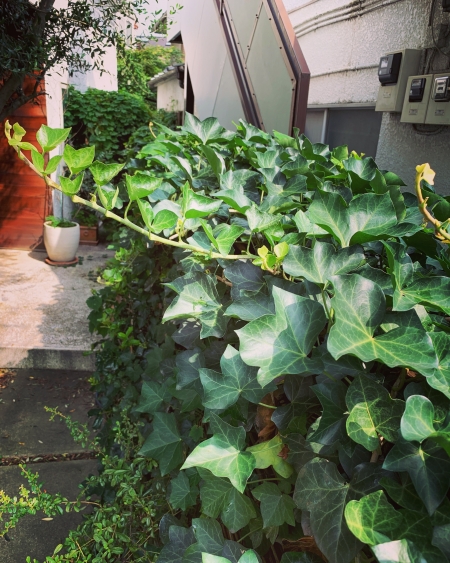20世紀の蔦
支えがあると、それを伝わって、どんどん伸びる、どんどん成長する、どんどん太くなるのに、単独だと、ぜんぜん伸びもしないし、ぜんぜん成長もしないし、ぜんぜん大きくならないという。
うちには某建築家の「母の家」から拝借してきた蔦が地植えしてある。もう20年もので、一度転居した時も連れてきて、二度くらい、あまりにも成長したので伐採してもらい、それでも塀を覆いつくし、日々の手入れでは追いつかないので、今日また何年振りかに伐採してもらった。
完全に無くなるのは忍びがなく、その話をしたら欲しいという人もいたので、かなり伐採して、また生えてくるのか心配なくらいまで綺麗さっぱりになったが、室内で観葉植物として育ててみようということになり、少しだけ確保して水挿ししてあり、他にも、外の植木鉢に移し替えたり、よく見たら地植えしたものも葉が残っていた。
で、植木屋さんに尋ねたら、先の回答、植物には疎いので、ならば、最初から室内で観葉植物として育てればとも思いつつ、蔦は外を覆い尽くすあの感じが良いと、20世紀のモダニズムの建築家は蔦好きだからなと思いつつ、支えがあると成長するという話が面白い、確かに塀に這っている蔦はとても太いのに、観葉植物としての蔦は、ネットの画像を見たが、細い。
観葉植物の蔦には荒々しさが無く、か弱い感じ、そこが良いのかもしれないが、支えが無くても、どんどん成長して、支えが無ければ、横に這ってでも、何か掴まるものを見つけて、あの荒々しい、何にでも絡みつく感じになるのかと思っていたし、イメージは「母の家」の蔦なので、外壁にも這っていく生命力と思いきや、外壁があるから生命力を発揮できたのか、支えがある無しでこの違い。
ずっと、モダニズム建築の蔦は、場所性を捨てた建築に、場所性を取り戻す役目を負わせるために、わざと後から生えてくるように、建築家がしていたのだろうと勝手な解釈をしていたが、蔦の方も格好の餌食が如く建築を利用しており、むしろ、都合よく使われるフリをして、モダニズム建築を覆い尽くしてしまおう、場所に埋没させてしまえと野望を燃やしていたり。
やっぱり、蔦は貴重だから、大事にしよ、また塀を覆い尽くすかな。
"Twentieth Century Trap"
If there is support, it is transmitted and it grows steadily, grows steadily, it gets thicker, but when it is alone, it does not grow at all, it does not grow at all, and it does not grow at all.
Inside, there is a cocoon planted from the "mother's house" by a cocoon architect. It's already 20 years, I brought it when I moved, and it was grown too twice, so I felled it, but it still covered the firewood and I can not catch up with daily care, so it is the first time in several years today I was cut down.
There was no shinobi that completely disappeared, and there was a person who wanted to talk about it, so it fell pretty clean and I was worried whether it would grow again, but I tried to grow it as a houseplant in the room As a result, a small amount was secured and water was inserted, and there were also leaves that were transferred to outside flower pots or planted on the ground if looked closely.
Then, when I asked the gardener, the previous answer, I am not familiar with the plant, so if I think that I should grow it as a houseplant indoors from the beginning, the feeling that the moths cover the outside is good, 20th century I think that modernist architects love cocoon, but it is interesting to hear that it grows when it is supported. I saw it but it was thin.
The foliage of the foliage plant is not rough, it feels weak, and it may be good, but even if there is no support, it grows steadily, if there is no support, you can grab something even if you crawl sideways I found something and thought that it would feel like that rough, tangled with anything, and the image is the "mother's house" trap, so I think that it is the vitality that hits the outer wall, because there is an outer wall This difference without support, whether you have been able to demonstrate the vitality.
For a long time, modernist architecture traps interpreted the architects as if they were to grow up on purpose in order to restore the place to a place where place was abandoned. However, the samurai also uses architecture like a prey, but rather, pretend to be used conveniently and cover modernism architecture, even if it is buried in the place and burns ambitions. Or
After all, moths are precious, so take care of them and cover them again.

